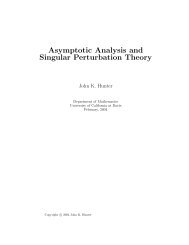Bounded Linear Operators on a Hilbert Space
Bounded Linear Operators on a Hilbert Space
Bounded Linear Operators on a Hilbert Space
Create successful ePaper yourself
Turn your PDF publications into a flip-book with our unique Google optimized e-Paper software.
The adjoint of an operator 195<br />
This proves that ran A ⊂ (ker A ∗ ) ⊥ . Since (ker A ∗ ) ⊥ is closed, it follows that<br />
ran A ⊂ (ker A ∗ ) ⊥ . On the other hand, if x ∈ (ran A) ⊥ , then for all y ∈ H we have<br />
0 = 〈Ay, x〉 = 〈y, A ∗ x〉.<br />
Therefore A ∗ x = 0. This means that (ran A) ⊥ ⊂ ker A ∗ . By taking the orthog<strong>on</strong>al<br />
complement of this relati<strong>on</strong>, we get<br />
(ker A ∗ ) ⊥ ⊂ (ran A) ⊥⊥ = ran A,<br />
which proves the first part of (8.12). To prove the sec<strong>on</strong>d part, we apply the first<br />
part to A ∗ , instead of A, use A ∗∗ = A, and take orthog<strong>on</strong>al complements. <br />
An equivalent formulati<strong>on</strong> of this theorem is that if A is a bounded linear operator<br />
<strong>on</strong> H, then H is the orthog<strong>on</strong>al direct sum<br />
H = ran A ⊕ ker A ∗ .<br />
If A has closed range, then we obtain the following necessary and sufficient c<strong>on</strong>diti<strong>on</strong><br />
for the solvability of (8.11).<br />
Theorem 8.18 Suppose that A : H → H is a bounded linear operator <strong>on</strong> a <strong>Hilbert</strong><br />
space H with closed range. Then the equati<strong>on</strong> Ax = y has a soluti<strong>on</strong> for x if and<br />
<strong>on</strong>ly if y is orthog<strong>on</strong>al to ker A ∗ .<br />
This theorem provides a useful general method of proving existence from uniqueness:<br />
if A has closed range, and the soluti<strong>on</strong> of the adjoint problem A ∗ x = y is<br />
unique, then ker A ∗ = {0}, so every y is orthog<strong>on</strong>al to ker A ∗ . Hence, a soluti<strong>on</strong> of<br />
Ax = y exists for every y ∈ H. The c<strong>on</strong>diti<strong>on</strong> that A has closed range is implied by<br />
an estimate of the form cx ≤ Ax, as shown in Propositi<strong>on</strong> 5.30.<br />
A comm<strong>on</strong>ly occurring dichotomy for the solvability of a linear equati<strong>on</strong> is summarized<br />
in the following Fredholm alternative.<br />
Definiti<strong>on</strong> 8.19 A bounded linear operator A : H → H <strong>on</strong> a <strong>Hilbert</strong> space H<br />
satisfies the Fredholm alternative if <strong>on</strong>e of the following two alternatives holds:<br />
(a) either Ax = 0, A ∗ x = 0 have <strong>on</strong>ly the zero soluti<strong>on</strong>, and the equati<strong>on</strong>s<br />
Ax = y, A ∗ x = y have a unique soluti<strong>on</strong> x ∈ H for every y ∈ H;<br />
(b) or Ax = 0, A ∗ x = 0 have n<strong>on</strong>trivial, finite-dimensi<strong>on</strong>al soluti<strong>on</strong> spaces of<br />
the same dimensi<strong>on</strong>, Ax = y has a (n<strong>on</strong>unique) soluti<strong>on</strong> if and <strong>on</strong>ly if y ⊥ z<br />
for every soluti<strong>on</strong> z of A ∗ z = 0, and A ∗ x = y has a (n<strong>on</strong>unique) soluti<strong>on</strong> if<br />
and <strong>on</strong>ly if y ⊥ z for every soluti<strong>on</strong> z of Az = 0.<br />
Any linear operator A : C n → C n <strong>on</strong> a finite-dimensi<strong>on</strong>al space, associated with<br />
an n × n system of linear equati<strong>on</strong>s Ax = y, satisfies the Fredholm alternative.<br />
The ranges of A and A ∗ are closed because they are finite-dimensi<strong>on</strong>al. From<br />
linear algebra, the rank of A ∗ is equal to the rank of A, and therefore the nullity
















